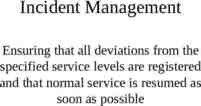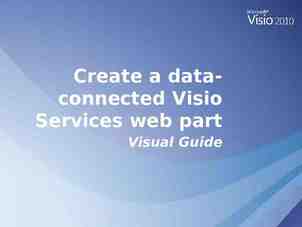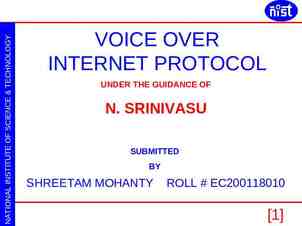Service-centric Software Engineering Ian Sommerville 2006
42 Slides1.00 MB
Service-centric Software Engineering Ian Sommerville 2006 Software Engineering, 8th edition. Chapter 31 Slide 1
Objectives To explain the notion of a reusable service, based on web service standards, that provides a mechanism for inter-organisational computing; To describe the service engineering process that is intended to produce reusable web services; To introduce service composition as a means of application development; To show how business process models may be used as a basis for the design of service-oriented systems. Ian Sommerville 2006 Software Engineering, 8th edition. Chapter 31 Slide 2
Topics covered Services as reusable components Service engineering Software development with services Ian Sommerville 2006 Software Engineering, 8th edition. Chapter 31 Slide 3
Service-oriented architectures A means of developing distributed systems where the components are stand-alone services Services may execute on different computers from different service providers Standard protocols have been developed to support service communication and information exchange Ian Sommerville 2006 Software Engineering, 8th edition. Chapter 31 Slide 4
(U DD Ser reg istr Find Pu Serv Se S requ Bin O Apr P (W Service-oriented architectures Ian Sommerville 2006 Software Engineering, 8th edition. Chapter 31 Slide 5
Benefits of SOA Services can be provided locally or outsourced to external providers Services are language-independent Investment in legacy systems can be preserved Inter-organisational computing is facilitated through simplified information exchange Ian Sommerville 2006 Software Engineering, 8th edition. Chapter 31 Slide 6
XML tech T , . Supp , W Pro Serv Mes T rans , ,H. Web service standards Ian Sommerville 2006 Software Engineering, 8th edition. Chapter 31 Slide 7
Key standards SOAP WSDL (Web Service Definition Language) This standard allows a service interface and its bindings to be defined UDDI A message exchange standard that supports service communication Defines the components of a service specification that may be used to discover the existence of a service WS-BPEL A standard for workflow languages used to define service composition Ian Sommerville 2006 Software Engineering, 8th edition. Chapter 31 Slide 8
Service-oriented software engineering Existing approaches to software engineering have to evolve to reflect the service-oriented approach to software development Service engineering. The development of dependable, reusable services Software development for reuse Software development with services. The development of dependable software where services are the fundamental components Software development with reuse Ian Sommerville 2006 Software Engineering, 8th edition. Chapter 31 Slide 9
Services as reusable components A service can be defined as: A loosely-coupled, reusable software component that encapsulates discrete functionality which may be distributed and programmatically accessed. A web service is a service that is accessed using standard Internet and XML-based protocols A critical distinction between a service and a component as defined in CBSE is that services are independent Services do not have a ‘requires’ interface Services rely on message-based communication with messages expressed in XML Ian Sommerville 2006 Software Engineering, 8th edition. Chapter 31 Slide 10
W aW iter Din h at w T o mat And Fillet How Rare W iSalad th sa E T C. Synchronous interaction Ian Sommerville 2006 Software Engineering, 8th edition. Chapter 31 Slide 11
An order as an XML message starter dish name “soup” type “tomato” / dish name “soup” type “fish” / dish name “pigeon salad” / /starter main course dish name “steak” type “sirloin” cooking “medium” / dish name “steak” type “fillet” cooking “rare” / dish name “sea bass” /main accompaniment dish name “french fries” portions “2” / dish name “salad” portions “1” / /accompaniment Ian Sommerville 2006 Software Engineering, 8th edition. Chapter 31 Slide 12
Web service description language The service interface is defined in a service description expressed in WSDL. The WSDL specification defines What operations the service supports and the format of the messages that are sent and received by the service How the service is accessed - that is, the binding maps the abstract interface ontoa concrete set of protocols Where the service is located. This is usually expressed as a URI (Universal Resource Identifier) Ian Sommerville 2006 Software Engineering, 8th edition. Chapter 31 Slide 13
WSD XM L n Intro T y p Abst face Int fa Me Con Bin impl En Structure of a WSDL specification Ian Sommerville 2006 Software Engineering, 8th edition. Chapter 31 Slide 14
A WSDL description fragment Define some of the types used. Assume that the namespace prefixes ‘ws’ refers to the namespace URI for XML schemas and the namespace prefix associated with this definition is weathns. types xs: schema targetNameSpace “http ://./weathns” xmlns: weathns “http:// /weathns” xs:element name “PlaceAndDate” type “pdrec” / xs:element name “MaxMinTem p” type “mmtrec” / xs: element name “InDataFault ” type “errmess” / xs: complexType name “pdrec” xs: sequence xs:element name “tow n” type “xs:string”/ xs:element name “country ” type “xs:string”/ xs:element name “day” type “xs:date” / /xs:complexTyp e Definitions of MaxMinType and InDataFault here /schema /types Ian Sommerville 2006 Software Engineering, 8th edition. Chapter 31 Slide 15
A WSDL description fragment 2 Ian Sommerville 2006 Software Engineering, 8th edition. Chapter 31 Slide 16
Service engineering The process of developing services for reuse in service-oriented applications The service has to be designed as a reusable abstraction that can be used in different systems Involves Service candidate identification Service design Service implementation Ian Sommerville 2006 Software Engineering, 8th edition. Chapter 31 Slide 17
Servi Se cand Ser im ident an Servi Serv fac V a l requi spe de The service engineering process Ian Sommerville 2006 Software Engineering, 8th edition. Chapter 31 Slide 18
Service candidate identification Three fundamental types of service Utility services that implement general functionality used by different business processes Business services that are associated with a specific business function e.g., in a university, student registration Coordination services that support composite processes such as ordering Ian Sommerville 2006 Software Engineering, 8th edition. Chapter 31 Slide 19
Service classification Task Entity Ian Sommerville 2006 Utility Currency convertor Employee locato r Document style check er Web form to XML converter Business Validate claim form Check credit rating Expenses form Student application form Software Engineering, 8th edition. Chapter 31 Co ordination Process expense claim Pay external supplier Slide 20
Service identification Is the service associated with a single logical entity used in different business processes? Is the task one that is carried out by different people in the organisation? Is the service independent? Does the service have to maintain state? Is a database required? Could the service be used by clients outside the organisation? Are different users of the service likely to have different non-functional requirements? Ian Sommerville 2006 Software Engineering, 8th edition. Chapter 31 Slide 21
Catalogue services Created by a supplier to show which good can be ordered from them by other companies Service requirements Specific version of catalogue should be created for each client Catalogue shall be downloadable The specification and prices of up to 6 items may be compared Browsing and searching facilities shall be provided A function shall be provided that allows the delivery date for ordered items to be predicted Virtual orders shall be supported which reserve the goods for 48 hours to allow a company order to be placed Ian Sommerville 2006 Software Engineering, 8th edition. Chapter 31 Slide 22
Catalogue - Non-functional requirements Access shall be restricted to employees of accredited organisations Prices and configurations offered to each organisation shall be confidential The catalogue shall be available from 0700 to 1100 The catalogue shall be able to process up to 10 requests per second Ian Sommerville 2006 Software Engineering, 8th edition. Chapter 31 Slide 23
Catalogue service operations Operation Description MakeCatalogue Creates a version of the cat alogue tailored for a specific customer. Includes an o ptional parameter to create a downloadable PDF version of the catalogue. Compare Provides a comparison of up to 6 characteristics (e.g. price, dimensions, p rocessor speed, etc .) of up to 4 catalogue it ems for comparison. Lookup Displays all of the data assoc iated with a specified catalogue item. Search This operation takes a logical expression and searche s the cat alogue according to that ex pression. It displays a list of all items that match the search expressi on. CheckDelivery Returns the predicted delivery date for an item if it is ordered today. MakeVirtualOrder Reserves the number of items to be ordered by a customer and provides item information for the customer’s own procurement system. Ian Sommerville 2006 Software Engineering, 8th edition. Chapter 31 Slide 24
Service interface design Involves thinking about the operations associated with the service and the messages exchanged The number of messages exchanged to complete a service request should normally be minimised. Service state information may have to be included in messages Ian Sommerville 2006 Software Engineering, 8th edition. Chapter 31 Slide 25
Interface design stages Logical interface design Message design Starts with the service requirements and defines the operation names and parameters associated with the service. Exceptions should also be defined Design the structure and organisation of the input and output messages. Notations such as the UML are a more abstract representation than XML WSDL description The logical specification is converted to a WSDL description Ian Sommerville 2006 Software Engineering, 8th edition. Chapter 31 Slide 26
Catalogue interface design Operation Inputs Out puts Exce ptions MakeCatalogue mcIn Company id PDF-flag mcOut URL of the catalogue for that company mcFault Inv alid company id Compare compIn Company id Entry attribute (up to 6) Catalogue number (up to 4) compOut URL of page comparison table compFault Inv alid company id Inv alid catalogue number Unknown attribute Lookup lookIn Company id Catalogue number lookOut URL of page with the item information lookFault Inv alid company id Inv alid catalogue number Search searchIn Company id Search string searchOut URL of web page with search results searchFault Inv alid company id Badly-formed search string CheckDelivery gdIn Company id Catalogue number Number of items required gdOut Catalogue number Expected delivery date gdFault Inv alid company id Inv alid catalogue number No availability Zero items requested PlaceOrder poIn Company id Number of items required Catalogue number poOut Catalogue number Number of items required Predicted delivery date Unit price estimate Total price estimate poFault Inv alid company id Inv alid catalogue number Zero items requested Ian Sommerville 2006 showing Software Engineering, 8th edition. Chapter 31 Slide 27
gdIn size D) cI D: str 0 catNu num numIt gdOu size 0 catNu deli od delivD Inva gdF ault errC errCo No errC Zer Input and output message structure Ian Sommerville 2006 Software Engineering, 8th edition. Chapter 31 Slide 28
Service implementation and deployment Programming services using a standard programming language or a workflow language Services then have to be tested by creating input messages and checking that the output messages produced are as expected Deployment involves publicising the service using UDDI and installing it on a web server. Current servers provide support for service installation Ian Sommerville 2006 Software Engineering, 8th edition. Chapter 31 Slide 29
A UDDI description Details of the business providing the service An informal description of the functionality provided by the service Information where to find the service’s WSDL specification Subscription information that allows users to register for service updates Ian Sommerville 2006 Software Engineering, 8th edition. Chapter 31 Slide 30
Legacy system services An important application of services is to provide access to functionality embedded in legacy systems Legacy systems offer extensive functionality and this can reduce the cost of service implementation External applications can access this functionality through the service interfaces Ian Sommerville 2006 Software Engineering, 8th edition. Chapter 31 Slide 31
« s » e « s » ervi « s » er Lo in Main F a cil getJo add ad suspe dele de comp edit qu Mai t lega Legacy system access Ian Sommerville 2006 Software Engineering, 8th edition. Chapter 31 Slide 32
Software development with services Existing services are composed and configured to create new composite services and applications The basis for service composition is often a workflow Workflows are logical sequences of activities that, together, model a coherent business process For example, provide a travel reservation services which allows flights, car hire and hotel bookings to be coordinated Ian Sommerville 2006 Software Engineering, 8th edition. Chapter 31 Slide 33
Book Book Arra Bro B flights hote car att a t Da Arriva ture dates Hot Vacation package workflow Ian Sommerville 2006 Software Engineering, 8th edition. Chapter 31 Slide 34
Construction by composition F o rmula Cre Discov Selec Refi T e outline wo servic servi wor s e workflo pro ram W o Exe rkfl D W o rkflow Servi Servic wo se speci des design Ian Sommerville 2006 Software Engineering, 8th edition. Chapter 31 Slide 35
Retr C No r Ho No vai Hote Hotels Chec vaila GetRe Ho Roo Re Hotel Confi Cust Hotel booking workflow Ian Sommerville 2006 Software Engineering, 8th edition. Chapter 31 Slide 36
Workflow design and implementation WS-BPEL is an XML-standard for workflow specification. However, WS-BPEL descriptions are long and unreadable Graphical workflow notations, such as BPMN, are more readable and WS-BPEL can be generated from them In inter-organisational systems, separate workflows are created for each organisation and linked through message exchange Ian Sommerville 2006 Software Engineering, 8th edition. Chapter 31 Slide 37
Res t No pr F a il Reque Setup Dow Sta t param data proces com OK OK Store Repo t result comp Check Alloca Co Initia A v ailabi resou Return result Interacting workflows Ian Sommerville 2006 Software Engineering, 8th edition. Chapter 31 Slide 38
Service testing Testing is intended to find defects and demonstrate that a system meets its functional and non-functional requirements Service testing is difficult as (external) services are ‘black-boxes’. Testing techniques that rely on the program source code cannot be used Ian Sommerville 2006 Software Engineering, 8th edition. Chapter 31 Slide 39
Service testing problems External services may be modified by the service provider thus invalidating tests which have been completed Dynamic binding means that the service used in an application may vary - the application tests are not, therefore, reliable The non-functional behaviour of the service is unpredictable because it depends on load If services have to be paid for as used, testing a service may be expensive It may be difficult to invoke compensating actions in external services as these may rely on the failure of other services which cannot be simulated Ian Sommerville 2006 Software Engineering, 8th edition. Chapter 31 Slide 40
Key points Service-oriented software engineering is based on the notion that programs can be constructed by composing independent services which encapsulate reusable functionality. Service interfaces are defined in WSDL. A WSDL specification includes a definition of the interface types and operations, the binding protocol used by the service and the service location. Services may be classified as utility services, business services or coordination services. The service engineering process involves identifying candidate services for implementation, defining the service interface and implementing, testing and deploying the service. Ian Sommerville 2006 Software Engineering, 8th edition. Chapter 31 Slide 41
Key points Service interfaces may be defined for legacy software systems which may then be reused in other applications. Software development using services involves creating programs by composing and configuring services to create new composite services. Business process models define the activities and information exchange in business processes. Activities in the business process may be implemented by services so the business process model represents a service composition. Techniques of software testing based on source-code analysis cannot be used in service-oriented systems that rely on externally provided services. Ian Sommerville 2006 Software Engineering, 8th edition. Chapter 31 Slide 42















































